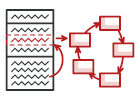
State in Python
State is a behavioral design pattern that allows an object to change the behavior when its internal state changes.
The pattern extracts state-related behaviors into separate state classes and forces the original object to delegate the work to an instance of these classes, instead of acting on its own.
Complexity:
Popularity:
Usage examples: The State pattern is commonly used in Python to convert massive switch-base state machines into objects.
Identification: State pattern can be recognized by methods that change their behavior depending on the objects’ state, controlled externally.
Conceptual Example
This example illustrates the structure of the State design pattern. It focuses on answering these questions:
- What classes does it consist of?
- What roles do these classes play?
- In what way the elements of the pattern are related?
main.py: Conceptual example
from __future__ import annotations
from abc import ABC, abstractmethod
class Context:
"""
The Context defines the interface of interest to clients. It also maintains
a reference to an instance of a State subclass, which represents the current
state of the Context.
"""
_state = None
"""
A reference to the current state of the Context.
"""
def __init__(self, state: State) -> None:
self.transition_to(state)
def transition_to(self, state: State):
"""
The Context allows changing the State object at runtime.
"""
print(f"Context: Transition to {type(state).__name__}")
self._state = state
self._state.context = self
"""
The Context delegates part of its behavior to the current State object.
"""
def request1(self):
self._state.handle1()
def request2(self):
self._state.handle2()
class State(ABC):
"""
The base State class declares methods that all Concrete State should
implement and also provides a backreference to the Context object,
associated with the State. This backreference can be used by States to
transition the Context to another State.
"""
@property
def context(self) -> Context:
return self._context
@context.setter
def context(self, context: Context) -> None:
self._context = context
@abstractmethod
def handle1(self) -> None:
pass
@abstractmethod
def handle2(self) -> None:
pass
"""
Concrete States implement various behaviors, associated with a state of the
Context.
"""
class ConcreteStateA(State):
def handle1(self) -> None:
print("ConcreteStateA handles request1.")
print("ConcreteStateA wants to change the state of the context.")
self.context.transition_to(ConcreteStateB())
def handle2(self) -> None:
print("ConcreteStateA handles request2.")
class ConcreteStateB(State):
def handle1(self) -> None:
print("ConcreteStateB handles request1.")
def handle2(self) -> None:
print("ConcreteStateB handles request2.")
print("ConcreteStateB wants to change the state of the context.")
self.context.transition_to(ConcreteStateA())
if __name__ == "__main__":
# The client code.
context = Context(ConcreteStateA())
context.request1()
context.request2()
Output.txt: Execution result
Context: Transition to ConcreteStateA
ConcreteStateA handles request1.
ConcreteStateA wants to change the state of the context.
Context: Transition to ConcreteStateB
ConcreteStateB handles request2.
ConcreteStateB wants to change the state of the context.
Context: Transition to ConcreteStateA
 WINTER SALE IS ON!
WINTER SALE IS ON!
